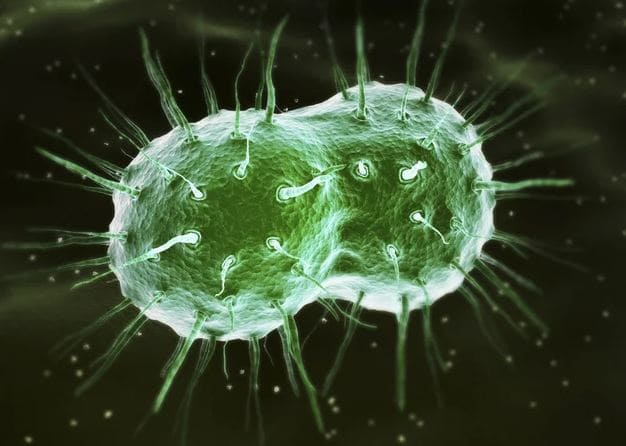Do you know that gonorrhea is one of the three most common sexually transmitted infections (STIs) in the United States? Yet, it is also among those infections that can go unnoticed for a long time while its causative bacterium does damage.

Gonorrhea
You will find in this article useful information about the infection. Find out what causes it, its symptoms, how to treat it, and what could happen if it goes untreated.
What is Gonorrhea?
Also referred to as gonococcal infection. Gonorrhea is a sexually transmitted infection caused by Neisseria gonorrhea. Its causal bacterium typically infects the genitals, rectum, and/or mouth.
In colloquial terms, it is also called “the clap”. This name is said to be a reference to a red-light district, Les Clapiers, in medieval Paris. The disease was believed to be more prevalent among prostitutes and homosexuals at the time.
A significant number of those who have the infection do not know. This increases the risk of its spread as well as complications.
How Does One Get Infected?
Being an STI, you are likely to get this infection when you engage in sexual activity with an infected person without protection.
The most common means of spreading is through vaginal, anal, or oral sex. The probability of getting an infection increases dramatically when people fail to use a condom or dental dam.
An infected person doesn’t have to show symptoms to be infectious.
Researchers say a man is about 20% likely to become infected from having sex with a woman carrying the N. gonorrhea bacterium after only one encounter, even if the latter shows no symptoms. The risk is higher for gay men.
For women, the risk of contracting the infection from single vaginal intercourse with a man having the bacterium can be as high as 80%.
Without having sex, people may still get an infection. This could happen through the careless sharing of sex toys, for instance. Infected pregnant women can also pass it on to their babies during childbirth.
The risk factors for getting gonorrhea infection include:
- Being young
- Having multiple sex partners
- Having sex with a sex worker or someone who has, or had, other sexual partners
- Past gonorrhea infection
- Other STIs
Symptoms of Gonorrhea
The first signs of a gonorrhea infection typically appear within two days to two weeks after exposure to the bacterium.
One of the symptoms you might notice is a sore throat. Gonorrhea could also result in redness of the eye (conjunctivitis) or swelling of lymph nodes around the neck.
Symptoms in women
Estimates have it that up to about 50 percent of women with gonorrhea do not show symptoms.
Symptoms include:
- Abnormal vaginal discharge
- Lower abdominal pain
- Burning or pain when passing urine
- Heavier periods or bleeding between periods
- Pain when having sex
In rare cases, infected women may bleed after having sexual intercourse.
Symptoms in men
Typical symptoms of infection in men include:
- Burning sensation when urinating as a result of inflammation of the urethra
- White, green, or yellow discharge from the penis
- Swollen or painful testis
gonorrhea can affect the eyes, anus, mouth, or joints. Infants who are infected may develop vision-threatening conjunctivitis.
Gonorrhea Trends
Gonorrhea is a very common sexual infection. It accounted for roughly 88 million of the 448 million new, yearly cases of curable STIs, according to a 2012 report by the World Health Organization (WHO).
The incidence is greater among women, compared to men. Most of these infections occur during the early years of adulthood.
In the United States, gonorrhea is the second-most common bacterial STI. The Centers for Disease Control and Prevention (CDC) states in the 2018 Sexually Transmitted Disease Surveillance report that there were 583,405 reported cases during the year.
Since dipping to an all-time low in 2009, the incidence of gonorrhea has been increasing almost every year. Cases rose by more than 82 percent between that year and 2018.
Diagnosis of Gonorrhea
In the past, laboratory professionals made use of culture and Gram stain for diagnosis. But nucleic acid amplification (NAA) tests are now the gold standard for testing. Methods based on polymerase chain reaction (PCR), in particular, are becoming increasingly popular.
Using a urine sample or swab, PCR tests seek for genes that are peculiar to the bacterium that causes gonorrhea.
Doctors mainly use cultures to establish what antibiotics would be best for tackling the infection in recent times.
With a service such as STDCheck, it is a lot easier to get tested for gonorrhea and other STIs these days. You simply need to produce a little urine sample and take it to any of about 4,500 centers nationwide. Also, you don’t have to wait around at the center – just drop your sample and wait for results via email after 1-2 days.
STDCheck uses an FDA-cleared NAA test for diagnosis.
Treatment of Gonorrhea
You can treat and cure this infection easily, particularly when you seek help earlier. Antibiotics are the choice of treatments for combating it.
As a result of the rising incidence of antibiotic resistance, your doctor may recommend two drug forms: pill and injection. Ceftriaxone injection and oral azithromycin are currently the preferred options for treating gonorrhea.
Erythromycin ointment may be used to prevent eye infections in newborns.
It is crucial to complete your full treatment course before having sex with your partner again. Being cured of gonorrhea doesn’t make you immune to future infection.
Complications of Gonorrhea
Without treatment, N. gonorrhea can move from the point of primary infection to other parts of the body. The infection can spread to the skin, joints, and other organs.
Untreated gonorrhea can cause the following complications, among others:
- Infection of the tubes carrying sperm from the testicles in men
- Pelvic inflammatory disease (PID) in women
- Infertility
- Fever
- Inflammation or swelling of tendons and joints
- Meningitis
- Skin redness and irritation
- Pain in the scrotum
- Septic arthritis
- Blindness in both infants and adults as a result of conjunctivitis.
In rare cases, the infection may reach the heart and result in endocarditis.
The foregoing underscores the importance of prevention or at least prompt diagnosis and, treatment of gonorrhea.
References
https://www.cdc.gov/std/stats18/gonorrhea.htm
Related Articles:
Three STDs In US Reach Record High CDC Says
A Guide To Staying Free Of STDs As A Promiscuous Sex Addict
Study: Charcoal Enhances Efficacy of Herpes Medication
The Current Methods Available For HPV Testing In Women
HPV Tests for Men To Prevent Penile, Anal, and Throat Cancer
So Called Virgins Could Be Spreading HIV, Herpes, HPV, Gonorrhea, Chlamydia, and Syphilis
FEEDBACK:



